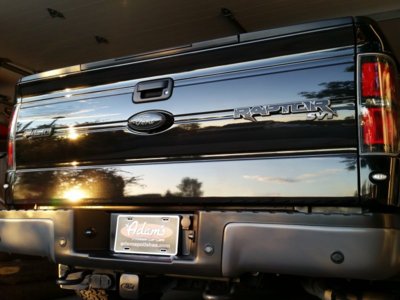H2O Guard & Gloss on a Raptor
For those of you that have not tried the
H2O Guard & Gloss, it is a water-activated sealant that is applied when the vehicle is still wet, right after a thorough wash. This application method saves time not having to dry first, and the product can be applied and provides protection to all exterior surfaces: paint, glass, plastic trim, vinyl, and running boards.
After a few times applying the H2O Guard & Gloss using the wet method, I found that the truck is too big to apply and dry-wipe a panel at a time. I also found that I spent too much time going back and getting splatters off of panels and windows that were already done.
So, rather than the spray on, wet wipe, then dry wipe for each panel, I have been spraying the product on in about 3-4 larger areas and immediately wiping with the wet towel.
For example, I will spray the hood, windshield, and roof, then go right to spreading the product with the plush microfiber towel that is damp. Then, I will do one side, windows , fenders, door panels, tailgate, and wet wipe.
Next, spray the other side and front, then wet wipe.
As the damp towel gets saturated, wring it out between applications. Then, I use the damp towel that has product on it to wipe the bumpers and then finish with the running boards.
With the product applied and spread on basically every surface of the truck, you will see some streaking and splatters. For the final step, I get a new plush microfiber towel, get it damp to the level of wrung out, then spray some H2O Guard & Gloss directly onto both sides of the towel. I also grab a dry, plush microfiber towel for final buffing. Using both towels, I will go back over the whole truck a panel or window at a time, wet wiping to remove any streaks or splatters, then dry wipe any leftover residue. Working from top to bottom; doing the hood, windshield, and roof; then the windows; then the fenders and doors; and finishing on the bumpers and running boards.
This sounds like a lot of work, but it goes really fast. I can do an application in 20-30 minutes (after a thorough wash).
One advantage of this method over the process shown in the video, is that you don't need three hands (one to spray and one for each towel), and you don't have to worry about splatters from overspray. Another advantage is it is faster, so you can get the water wiped away before it dries and potentially causes water spots. This is why wringing the towel out as you go is needed, to get the water off the surface before it dries.
This product should also be applied in the shade, and on cool surfaces. You cannot work in the sun or on hot surfaces, or the water will dry too fast and spot. How fast you have to work to avoid spots depends on your water quality. If you have really hard water, and have to really rush to get dried after a basic wash to avoid spots, then the dry application method may be your best option. Watch the product video for a demo of this method.
The reason I switch to a fresh towel for the final wet wipe, is just in case the original application towel ends up with any dirt from the lower areas. This is also why I work top to bottom, and finish on the bumpers and running boards, which may have residual dirt hiding out in the nooks and crannies.
Any of the plush microfiber towels will work, but I prefer the
Borderless Gray Towels. Since the product is light gray, it can stain white towels, but this does not show up on the Borderless Gray Towels.
One last tip, wear nitrile or latex gloves, or your hands will smell like grape soda for the rest of the day!
Here's a pic from a recent application.




